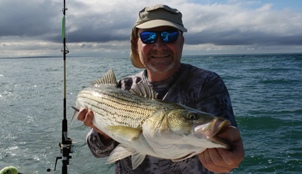Live Pogy Fishing

Capt. Todd MacGregor, MAC-ATAC Sportfishing, Fairhaven, MA
Pogy fishing was not on my original article list and I really do not enjoy all aspects of Pogy fishing, unlike most other methods. However, a fisherman must be a pragmatist and one must stick and move likes a boxer in order to ensure consistent success. Much like the 2006 season, the Pogies showed up thick in mid June. When this happens, the fishery changes and one must adapt quickly. For the most part, the night bite, trolling Danny and Gibbs plugs, was non-existent for the second half of June. The fish moved to a day bite and the pogies were the ticket. The bottom line if that live pogies can be like taking a machine gun to a fist fight. Live bait gives you a huge advantage when fishing is slow.
“As with all of my articles, I will clearly outline the step-by-step instructions so that any fisherman can easily follow and apply this method.”
The first step the bait well. Menhaden (pogies) are not as easy to keep alive as eels or scup, but there are easy solutions. I use an old blue chemical barrel cut down to the height of the gunnel so the tank can second as a seat. I had a nice hinged top made just to keep the water in while I am transiting in a heavy sea. I have a pump to feed water, a cheap aerator pump (optional), and most importantly, an overflow at the top of the tank. Dumping a 5 gallon bucket of water in 5 or 6 times an hour can substitute for the aerator pump.
Getting the bait: This is next riddle to solve. It seems to be easier at dawn with little wind. You will generally be able to see the schools, especially around Padanaram, Nonquit, Clarks Cove and New Bedford Harbor. I generally let the customers snag the baits and teach them the techniques for not spooking the schools and getting the bait to the boat without it getting chopped up by a bluefish. We also use cast nets and gill nets but this is a more complicated operation. Sneak up on the schools and cut the engine. Position the boat so it drifts down on the school and keep casts as short as possible. This allows for less time for Mr. Bluefish to chop up the bait. Once you snag a Pogy, real as hard as you can to get it skipping along the surface. One other note is that you need to use a wire leader ahead of the snag hook. Once you get 20 – 30, or however many you can get into the well, you are ready to go fishing. Don’t piss away too much time getting bait as you are wasting valuable fishing time.
The tackle: use anything you already have rigged. I use the same rods I utilize for casting eels (see last month’s article) and generally rigged the same way. I generally hook the pogy through the nostrils because they won’t bleed out as fast. Sometimes, I will hook them in front or behind the dorsal fin or even just ahead of the tail, depending on what I want to make that Pogy do. A variation is to use a small treble hook in the nose or near the dorsal. I use treble hook when the Pogies are getting harassed by 10-20 lb fish whose mouths are too small to eat a 14-16” pogy. This allows you to ‘snag’ the bass when he comes up to harass the Pogy. If I am fishing in deeper water, I will use a rubber core or even a 3 way to get the Pogy to go down but I generally fish these in shallow water with no weight. I sometimes slow troll the pogies by hooking them through the nose. If conditions allow me to handle the boat, I typically ‘bump troll’, similar to tube fishing by taking the boat in and out of gear to get the pogy to go down & then swim up when the boat is taken out of gear. This method can attract a lot of attention, in the late fall, and I have seen 40 lb bass come out of the water and hit the pogy like a bluefish hits a popping plug.
Locations to fish: I use the Pogies at or near all of the locations where I cast or drift eels. But, don’t ignore the location where you find the school. If I think there are bass or even big bluefish there, I may re-hook a Pogy after snagging and let it swim. This works best if there are large schools and you don’t have to keep moving to get the bait. Some of the spots I like are the western shore of Pasque, Mishaum Point, and d the backside of Pasque and Nashawena.
Other trips to remember: Menhaden is an oily, high protein food source that truly attracts all fish. We use dead pogies for shark chum, chunk bait for bass and blues, and for any bottom fish. If you are snagging baits, you will mortally wound some. Take the dead pogies out of the live well and put them on ice. When you get back in, put 6 or 8 of them in zip lock bags with sea salt and baking soda. This hardens the bait up and helps keep it from being mush when thawed. As mentioned, these can be used in the shark chummer or you can cast frozen chunks up on the beach in areas where you have been catching fish on eels at night. The old timers call this ‘casting popsicles’.
No matter how you fish the bottom line is that you need to GO FISHING, don’t overcomplicate it, and have fun!
Capt. Todd MacGregor
Fairhaven, MA


